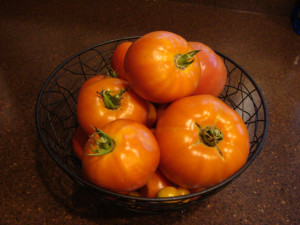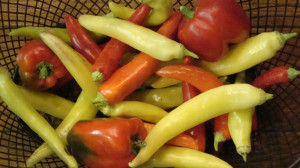By Ellen Chagnon | Photographed by Ellen Chagnon

I often hear the summer lament, “Oh, my garden has just burned up in this heat. All that work gone to waste!” I can sympathize. My garden churns out vegetables until (WHAM!) full-blown summer hits, with daytime temperatures reaching the high 90s (or even the low 100s) and nighttime readings dropping only to the 70s. These high temperatures are enough to challenge the toughest of plants, and combined with our frequent droughts, can be downright killers. With practice, I have learned how to keep my vegetable garden growing and even producing until the merciful temperatures of late summer and early fall arrive. I do this through a variety of techniques, including selecting plant varieties, watering faithfully, mulching, and using beneficial microclimates.
Good Genetics
In choosing my summer crops (such as beans, tomatoes, peppers, squash, and okra), I carefully read the descriptions for each variety in my seed catalogues and on websites, looking for clues like “heat- or drought-tolerant” that show me this plant can stand up to what our summers can hand out. Peppers and okra positively bask in the dog days of summer, sending forth fruit at a great rate. Some varieties of tomatoes and beans are more tolerant of heat than others, such as ‘Sun Sugar’ cherry tomato or ‘Kentucky Wonder’ pole bean. Good genetics go a long way in making a variety tolerant to difficult conditions.

Water, Water Everywhere
No life form can exist without water; vegetable plants sitting in full sun in midsummer need lots of it! Pots must be watered once or twice a day; raised beds often require daily watering; and in-ground gardens must receive one to two inches of water per week. Don’t let the soil in gardens and pots become bone dry before watering. Allowing the soil to dry out in the root zone will kill your plants’ fine rootlets, making them less able to take up water and likely to suffer damaging wilting. Water can be applied by hand, sprinkler, soaker hose, or drip irrigation. How you water depends on the equipment and the amount of water available, along with its cost. I prefer to hand water because it lets me adjust the amount of water to the type of plant. The time I spend watering allows me the opportunity to observe my plants carefully for signs of disease and insect damage. As I water, I enjoy the beauty of my garden.

Marvelous Mulch
I cannot say enough about the virtues of mulch as a tool for beating the heat in the vegetable garden. A properly-applied mulch of straw, hay, shredded leaves, shredded paper, or compost provides a cooler root zone and reduces moisture loss from the soil surface. Use several sheets of newspaper under the mulch to create an effective weed barrier. As a bonus, these materials add valuable organic matter to the soil as they break down. Beware of using plastic sheeting as mulch because its color absorbs light, increasing soil temperature. Also, plastic does not decompose into soil. Wood chips and bark mulch are poor choices for the vegetable garden due to their slow decomposition. Use shredded leaves and partially-decomposed compost only on mature plants; the pill bugs living in these materials chew on the stems of young seedlings, as I sadly discovered with my bean seedlings last year.

The Right Microclimate
A microclimate is a small area within the garden that provides a climate different from that of the surrounding area. Creating or selecting a microclimate for your plants can help mitigate the scorching rays of the summer sun. Plant sensitive summer crops in areas of the garden that receive some shade from an overhanging tree. Support a shade cloth or old sheets over plants to protect them from sun and drying winds. Pull pots closer to a building or a tree to move them from full sun into part sun. Plant your most sun-sensitive vegetables in the shade of taller crops: for example, plant your early summer lettuce to the north of your okra or between your pepper plants to allow it to receive shade much of the day.
Use good genetics, water, mulch, and the right microclimate to protect your vegetable garden from the summer’s heat!
M! April/May 2013

Leave a Reply